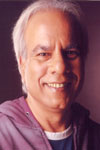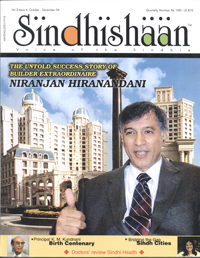ROOTS & WINGS
1920 to 2020 : A hundred year search for Sindhi identity
By Arun Babani

1920s began with the birth of a generation that at the prime of life witnessed partition and bore the consequent brutalities of migration. Back then it was the British Raj, and some ten odd lakh Hindu Sindhis lived content and peacefully on the banks of the Sindhu river, amidst Muslim Sindhis. Their forefathers held small jobs in cities or resided in villages as peasants.
1930s arrived with a clarion call to unite and oppose the British. The ‘Quit India’ movement was beginning to take shape just then, and like the rest of India, the Sindhi youth too joined the mission to help free their beloved motherland. Barely in their teens, their lives were spent in demonstrations and jails. This made them aware of their duties and responsibilities quite early in life, thereby making them strong willed and dedicated human beings.
1947, the struggle bore fruit, after much bloodshed; and while in their mid twenties they saw the light of freedom. The whole nation rejoiced, but Sindhis had to face the cruel reality of migration and displacement from their motherland Sindh. Sindhis came to Hind to find a new home, a new culture, a new reality.
1950 saw atleast three main categories of Sindhis trying to find roots in India:
a) the educated class who qualified for jobs,
b) the slightly rich who brought with them money and ornaments, enabling them to set up small business, and
c) the poor and illiterate who were compelled to struggle hard in camps, without any basic facilities for a decent living.
The common feature amongst all the Sindhis was that both men and women worked hard together, honestly and helped each other to set up a new home. Now was the time for the birth of the second generation of Sindhis in India. By and large Sindhis reared small families.
1960s a time when Sindhi education was possible in all corners of India, which was a blessing for the second generation born here. It made it possible for them to bring some of the Sindh in Hind. Instead of Bhagat Kanwarram there was Bhagat Chawla. This period witnessed an upsurge of Sindhi creativity in dramas, movies, music, poetry and literature; most of it depicting Sindhi reality and culture. An echo of the sindhu desh left behind was very strongly felt in these arts. This period also saw the emergence of Sindhi journalism with dozens of Sindhi magazines and newspapers published from all corners of India.
1970s the second generation of Sindhis entered colleges when Sindhi was still an optional subject, so was, Persian. By this time, almost a quarter of a century after partition, the first generation Sindhis had not just found their feet in India, but had flourished as well. They had found acceptance in the hearts of other Indian communities with their honest approach to life. Parallel to this prosperity was an earnest struggle to keep the lamp of Sindhiyat alive and burning. A massive effort was called for in order to achieve the task of spreading the Sindhi language and culture and preserving it. This was Herculean job as spoken Sindhi was quickly disappearing from homes since Sindhi schools were breathing their last.
1980s, began with the third generation of immigrant Sindhis, (2nd in India) that was born. By now the Sindhi culture, language and ethos, jointly called ‘SINDHIAT’ was on a shaky ground; if not as a patient on oxygen atleast like a tired and weak warrior. The first generation of Sindhis was slowly ebbing out of jobs and active life, giving way to their offspring of the second generation who are now in their prime. Although they were on firmer socio economic grounds unlike their parents who were refugees, they still had to attend to work and home. With no Sindhi schools in sight, Sindhis had no choice except English or Hindi medium schools for their kids. While Sindhis struggled to rebuild from ruins, their language and culture receded into the background, if not collapsed altogether. By 80s, thirty years from partition, Sindhis earned fame and money in abundance. From Kalyan to Kubernagar, from Pune to Patna, the transit camps built in 50s gave way to multi storeyed sky scrapers of 80s. In India, stories were told in admiration about Sindhis “they came, they saw, they conquered”. A Sindhi earned the reputation of a trustworthy, honest and hardworking chap. From medicine to modeling, from businessman to barrister, a Sindhi came to be admired and looked up to. From finding his roots to spreading his wings in a matter of three decades was a wonder of sorts!
1990s was a decade of finding alternatives. Sindhi magazines in English language hit the stands. In many parts of India even Hindi or Gujarati was accepted as an alternative to Sindhi in order to save the situation. Books on learning Sindhi in an easy and simple way were published, which helped the general cause of Sindhiyat. On one hand without schools the language was disappearing and on the other hand Sindhi software was developed for the first time. Some of the elders are of the opinion that even if Sindhi as a language does not survive, (S) hindi, or (S)inglish will appear as an alternative. Perhaps instead of the Sindhi name Daya, a (S)hindi name Diya will appear: Lori or Lullaby will replace Loli: although a Sindhi “Chaap” become a pattice it will still have the same taste of Sindhiyat. However the good news is that the Sindhi papad will always remain a papad!!!
2000 2020: Fourth generation of immigrant Sindhis (3rd in India) will be born around this time. It will also be the time for celebrating the first centenary of the first partitioned generation which was born in the 20s in Sindh. This will also be the time for soul searching, looking back in introspection, debating with ourselves about ourselves. Although our forefathers started from Sindh and landed in Hind, what will now be the identity of an average fourth generation, 21st century Sindhi?
An identity has two aspects inner and outer. Outwardly it is difficult to identity a Sindhi in rest of the Indian community. Names are Indian, dress code is western, and habits are international. What then is the inner identity of an average Sindhi? As generally observed, there are three distinct qualities that set a Sindhi apart from others:
a) Castelessness. A Sindhi is devoid of the caste concept, he firmly believes in SARVA DHARMA SAMABHAVA.
b) It is a distinct Sindhi quality to live in SHAANMAAN. It is no wonder that among the first Sindhi websites was the website called “Sindhishaan.com”
c) The most important Sindhi trait is that he is a lover of wealth (outer riches), and truth (inner riches).
Partition was obviously a curse for Sindhis, it scattered us and eventually we will lose our bond with our ancestral property in Mohan jo Daro. But if you look deeply into a Sindhi, you will notice that these ancestral ties will not break simply because it is not a piece or real estate or even a geographical entity. It is rather a Sachkhand, a reservoir of truth, an inner property that is passed through generations.
ABANO WARSO of a Sindhi is in his very genes; wherever he reaches he can’t help but be a Sindhi, which simply means SUTHO MAANHOO, SACHO MAANHOO, SAJO MAANHOO. (a good man, a true man, a whole man). With his roots in Sindhu Desh on the banks of the Sindhu, a hundred years later, the fourth generation Sindhi will open his wings and fly to the four corners of the universe. JHULELAL will still be there to make his BEDA PAAR, only then it will not be a Beda, but a supersonic jet. Awal khair.


